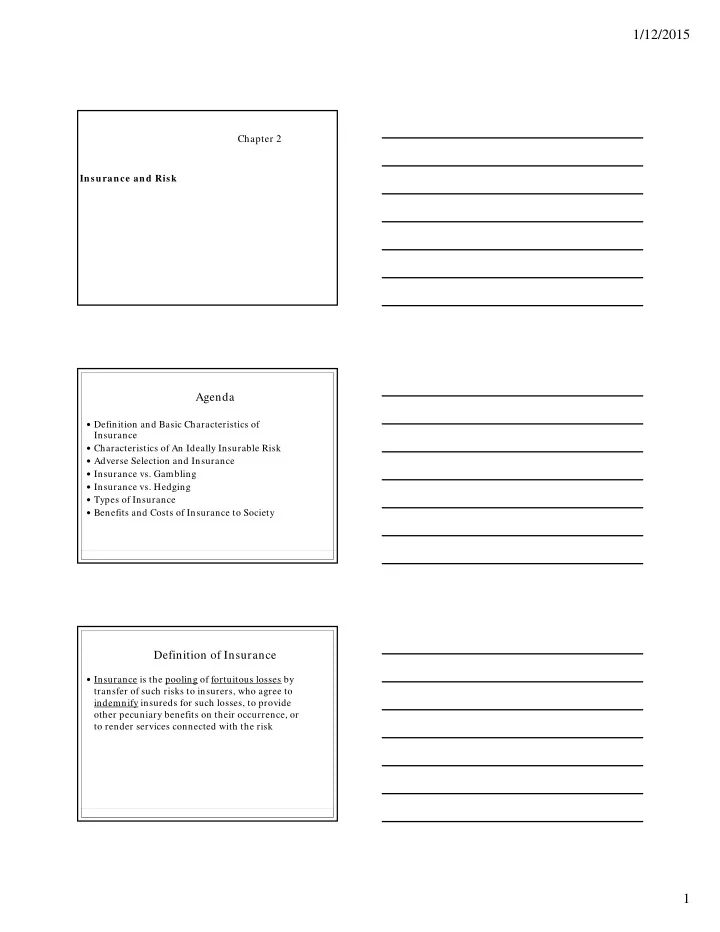

1/12/2015 Chapter 2 Insurance and Risk Agenda Definition and Basic Characteristics of Insurance Characteristics of An Ideally Insurable Risk Adverse Selection and Insurance Insurance vs. Gambling Insurance vs. Hedging Types of Insurance Benefits and Costs of Insurance to Society Definition of Insurance Insurance is the pooling of fortuitous losses by transfer of such risks to insurers, who agree to indemnify insureds for such losses, to provide other pecuniary benefits on their occurrence, or to render services connected with the risk 1
1/12/2015 Basic Characteristics of Insurance Pooling of losses Spreading losses incurred by the few over the entire group Risk reduction based on the Law of Large Numbers Payment of fortuitous losses Insurance pays for losses that are unforeseen, unexpected, and occur as a result of chance Risk transfer A pure risk is transferred from the insured to the insurer, who typically is in a stronger financial position Indemnification The insured is restored to his or her approximate financial position prior to the occurrence of the loss Pooling of Losses Ann and Bob own identical buildings Valued at $50,000 10 % each building will be destroyed Loss to either building is an independent event Loss Prob 0 .90 50 .10 Expected value, = 5,000 Standard deviation, = 15,000 for each owner Pooling of Losses Suppose Ann and Bob share their losses Loss Prob 0 .81 25 .09 25 .09 50 .01 Expected value, = 5,000 Standard deviation, = 15,000/ √ 2 = 10,606.60 for each owner 2
1/12/2015 Pooling of Losses Suppose others own identical buildings Valued at $50,000 10 % each building will be destroyed Loss to either building is an independent event Agree to share losses As pool expands, = 5,000 = 15,000/ √ N for each owner Same principle as diversifying stock portfolio Characteristics of an Ideally Insurable Risk Large number of exposure units to predict average loss Accidental and unintentional loss to control moral hazard to assure randomness Determinable and measurable loss to facilitate loss adjustment insurer must be able to determine if the loss is covered and if so, how much should be paid. Requirements of an Insurable Risk No catastrophic loss to allow the pooling technique to work exposures to catastrophic loss can be managed by: dispersing coverage over a large geographic area using reinsurance catastrophe bonds Calculable chance of loss to establish an adequate premium 3
1/12/2015 Requirements of an Insurable Risk Economically feasible premium so people can afford to buy Premium must be substantially less than the face value of the policy Based on these requirements: Most personal, property and liability risks can be insured Market risks, financial risks, production risks and political risks are difficult to insure Risk of Fire as an Insurable Risk Risk of Unemployment as an Insurable Risk 4
1/12/2015 Adverse Selection and Insurance Adverse selection is the tendency of persons with a higher-than-average chance of loss to seek insurance at standard rates If not controlled, adverse selection result in higher-than-expected loss levels Adverse selection can be controlled by: careful underwriting (selection and classification of applicants for insurance) policy provisions (e.g., suicide clause in life insurance) Insurance vs. Gambling Insurance Gam bling Insurance is a technique for Gambling creates a new handing an already existing speculative risk pure risk Gambling is not socially Insurance is socially productive productive: The winner’s gain comes at both parties have a common the expense of the loser interest in the prevention of a loss Insurance vs. Hedging Insurance Hedging Risk is transferred by a Risk is transferred contract by a contract Hedging involves risks that Insurance involves are typically uninsurable the transfer of Hedging does not result in insurable risks reduced risk Insurance can reduce the objective risk of an insurer through the Law of Large Numbers 5
1/12/2015 Types of Insurance Private Insurance Life and Health Property and Liability Government Insurance Social Insurance Social security, Medicare, Unemployment Other Government Insurance Private Insurance Life and Health Life insurance pays death benefits to beneficiaries when the insured dies Health insurance covers medical expenses because of sickness or injury Disability plans pay income benefits Property and Liability Property insurance indemnifies property owners against the loss or damage of real or personal property Liability insurance covers the insured’s legal liability arising out of property damage or bodily injury to others Casualty insurance refers to insurance that covers whatever is not covered by fire, marine, and life insurance Private Insurance Private insurance coverages can be grouped into two major categories Personal lines coverages that insure the real estate and personal property of individuals and families or provide protection against legal liability Commercial lines coverages for business firms, nonprofit organizations, and government agencies 6
1/12/2015 Property and Casualty Insurance Coverages Government Insurance Social Insurance Programs Financed entirely or in large part by contributions from employers and/ or employees Benefits are heavily weighted in favor of low-income groups Eligibility and benefits are prescribed by statute Examples: Social Security, Unemployment, Workers Comp Other Government Insurance Programs Found at both the federal and state level Examples: Federal flood insurance, state health insurance pools Social Benefits of Insurance Indemnification for Loss Contributes to family and business stability Reduction of Worry and Fear Insureds are less worried about losses Source of Investment Funds Premiums may be invested, promoting economic growth Loss Prevention Insurers support loss-prevention activities that reduce direct and indirect losses Enhancement of Credit Insured individuals are better credit risks than individuals without insurance 7
1/12/2015 Social Costs of Insurance Cost of Doing Business Insurers consume resources in providing insurance to society An expense loading is the amount needed to pay all expenses, including commissions, general administrative expenses, state premium taxes, acquisition expenses, and an allowance for contingencies and profit Cost of Fraudulent and Inflated Claims Payment of fraudulent or inflated claims results in higher premiums to all insureds, thus reducing disposable income and consumption of other goods and services 8
Recommend
More recommend